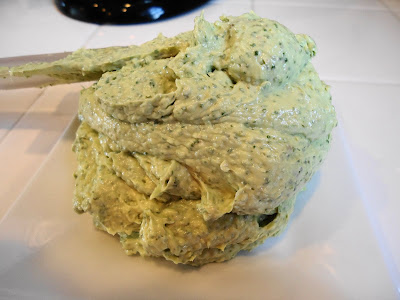Mmm, short ribs. Quite frankly one of my favorite cuts of beef. Usually they remind me of the cold, Winter months when I love to braise them all day, the aromas of bacon, onions, herbs filling the kitchen as the short ribs slowly simmer in a flavorful broth, becoming ever-so-tender and literally "falling off the bone".
But it's Summer, and utilizing the BBQ and dining outside is what I am all about. Plus, I wanted to experiment with short ribs in a different way.
I was lucky enough recently to purchase some incredible meat from Chaffin Orchards, to which I wrote about their amazing grass-fed filets a few weeks back (http://fiveoclockfood.blogspot.com/2010/06/sustainable-simple-just-plain-delicious.html). I was flipping through an issue of Fine Cooking's "Grilling" magazine I picked up at the market and saw an Asian-inspired recipe for braised and BBQ'ed short ribs. This was something worth trying!
(I modified the recipe slightly as I most often use recipes as guidelines rather than follow to a "T")
Ingredients:
Dry rub:
* 1T ancho chile power
* 1-2 t Chinese five spice
* 3 T brown sugar
* sea salt and ground black pepper
* 2-3 pounds short ribs, either flanken cut (as pictured above) or English cut (will just need to braise longer)
For braising:
* 2 T olive oil
* 1 onion, chopped
* 4-5 cloves garlic, roughly chopped
* 1"-2" piece of fresh ginger, roughly chopped
* 3 cups chicken broth
* 1/4 C low sodium soy sauce
* 1/4 C rice wine vinegar
* 3 T brown sugar
* 2 T fish sauce
* 1 star anise pod
First, the dry rub. These ribs really take the flavors on, so make sure to get this rub on the ribs at least 2 hours before cooking, preferably overnight. Mix together all of the dry ingredients in a small bowl:
Next, get that rub evenly spread all over the ribs:
Spicy, sugary, salty goodness.
Put the ribs in a plastic bag or baking dish covered with plastic wrap and let them "marinate" in the fridge until you are ready to cook.
When ready to begin the braising, bring the ribs out of the fridge for 20 minutes to let them come up to room temperature. Heat the olive oil in a deep pot on medium-high and add ribs, browning on all sides. They probably won't all fit in the pan at once, so just do this part in batches.
Remove from pot and set aside on plate.
Next up to the pot - onions, garlic and ginger. Add all three and cook on medium until the onions begin to soften, about 5 minutes.
Once the onions are soft, add the chicken stock, removing the browned bits from the bottom of the pan. Continue adding the soy sauce, rice wine vinegar, brown sugar, fish sauce, and star anise to the pot.
If you haven't cooked with start anise before, here's what it looks like. One pod packs a lot of flavor for a braise like this. Plus, it is one of the five ingredients in Chinese five spice used in the dry rub.
Add the short ribs back to the pot, making sure to "cover" or "submerge" the ribs as much as possible in the liquid. Bring the liquid to a boil, reduce it to a simmer on LOW heat, and cover with a lid. Make sure throughout the whole braising process that the liquid is never boiling but rather gently simmering. If the simmer is too high the meat will become extremely tough, and that is not what we are looking for.
And then, we wait. And wait. And wait. The aromas in my kitchen were tempting my taste buds, but I waited patiently. Check the ribs about every 30 minutes, making sure the liquid is simmering and the ribs are submerged. Total cooking time was about 2 hours (this also can be done in a slow cooker/crock pot, although times will vary).
Now, fire up that BBQ. In this case, I took the pot with the ribs over to a fellow foodie's house and we used his charcoal grill. Remove the ribs from the pot and reduce the braising liquid on the stove, reducing to thicken (there will be a small layer of oil on the top from the cooking process - you can skim it off or just leave it alone). Glaze the ribs with a little bit of the reduced liquid and get them on the grill.
We also threw on some asparagus and scallions for the short rib feast!
The ribs are already cooked, so you don't need to BBQ the heck of them. Just char them to get that fantastic crust on the outside.
And to plate: hit those ribs with some of the reduced sauce again. I made some jasmine rice to which I added toasted sesame seeds and the grilled scallions (chopped), and served alongside were the perfectly grilled asparagus. I couldn't wait to dig in.
I wish that this post had a "scratch and sniff" plug-in to explain just how delicious this meal was. The short ribs were fork tender and tasted AMAZING. All of the flavors, beginning with the dry rub then the braising liquid, were dancing around in my mouth. The char from the BBQ was perfect and slightly caramelized the brown sugar, adding just another depth of taste. Plus, the rice was the perfect, basic compliment to the otherwise complex sauce coating the ribs.
This is a new Summer staple for my recipe box. And, as I am back in Southern California where BBQ's are pretty much used year round, this recipe will probably find its way to a grill this Winter.
Cheers and enjoy!



























































